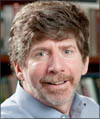Damage Resistant Braced Frames with Controlled Rocking and Energy Dissipating Fuses
PEER/UC Berkeley sponsored Seminar by Professor Deierlein
Monday, September 13, 2010
12:00-1:00 pm
502 Davis Hall, UC Berkeley
Presentation file (PDF -21.2 MB)
Abstract
 Experience from past earthquakes and risk of future losses highlight the need for buildings that are significantly less vulnerable to damage and easier to repair after major earthquakes. Of particular concern are conventional systems that may sustain extensive damage with large residual deformations that are difficult or practically impossible to repair. Our research aims to develop a new structural system that employs controlled frame rocking action and replaceable structural fuses that can sustain large earthquake motions with minimal damage. The system combines desirable aspects of conventional steel-braced framing with energy dissipating shear fuses that are mobilized through rocking action. Vertical post-tensioning provides self-centering overturning resistance to minimize residual drifts. These concepts will be described along with the planning, design, and observations of a large-scale three-story frame tested on the E-Defense facility in Japan. Shaking table tests under multiple ground motions and alternative fuse designs demonstrate the robustness of the system to sustain ground motions in excess of the Maximum Considered Earthquake motions without damage. Associated nonlinear analysis studies have been conducted to generalize the results for other frame configurations and to develop seismic design guidelines and criteria.
Experience from past earthquakes and risk of future losses highlight the need for buildings that are significantly less vulnerable to damage and easier to repair after major earthquakes. Of particular concern are conventional systems that may sustain extensive damage with large residual deformations that are difficult or practically impossible to repair. Our research aims to develop a new structural system that employs controlled frame rocking action and replaceable structural fuses that can sustain large earthquake motions with minimal damage. The system combines desirable aspects of conventional steel-braced framing with energy dissipating shear fuses that are mobilized through rocking action. Vertical post-tensioning provides self-centering overturning resistance to minimize residual drifts. These concepts will be described along with the planning, design, and observations of a large-scale three-story frame tested on the E-Defense facility in Japan. Shaking table tests under multiple ground motions and alternative fuse designs demonstrate the robustness of the system to sustain ground motions in excess of the Maximum Considered Earthquake motions without damage. Associated nonlinear analysis studies have been conducted to generalize the results for other frame configurations and to develop seismic design guidelines and criteria.
How to view the seminar
- – Attend in person at 502 Davis Hall, UC Berkeley on September 13, 2010 from 12:00pm - 1:00 pm
- – The video recording of this seminar will be available at the PEER Website any time after September 13th.
Speaker
Gregory Deierlein, Department of Civil and Environmental Engineering, Stanford University. Gregory Deierlein is the John A. Blume Professor of Engineering at Stanford University where he specializes in research on the design and behavior of steel and concrete structures, nonlinear structural analysis, fracture of metal structures, and performance-based design of structures for earthquakes and other extreme loads. He is the Director of the John A. Blume Earthquake Engineering Center at Stanford and former (2000-2007) Deputy Director of the Pacific Earthquake Engineering Research (PEER) Center. Deierlein is active in national technical organizations involved with developing building codes and standards, and he has served as a seismic design consultant and peer reviewer for buildings in California.
Sponsors
- – Structural Engineering, Mechanics and Materials, Department of Civil and Environmental Engineering, University of California, Berkeley
- – The Pacific Earthquake Engineering Research (PEER) Center

posted September 14, 2010

